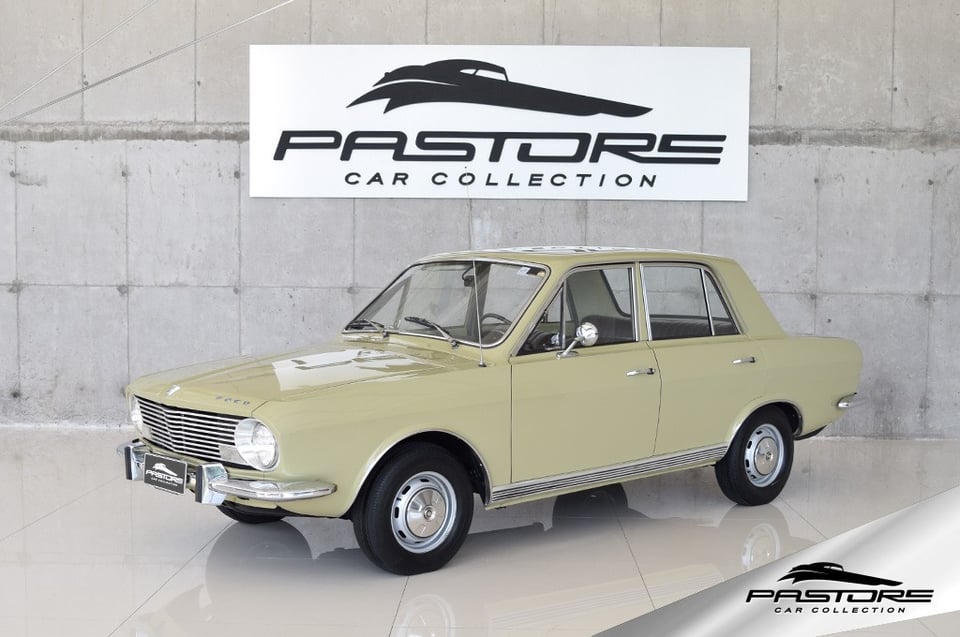
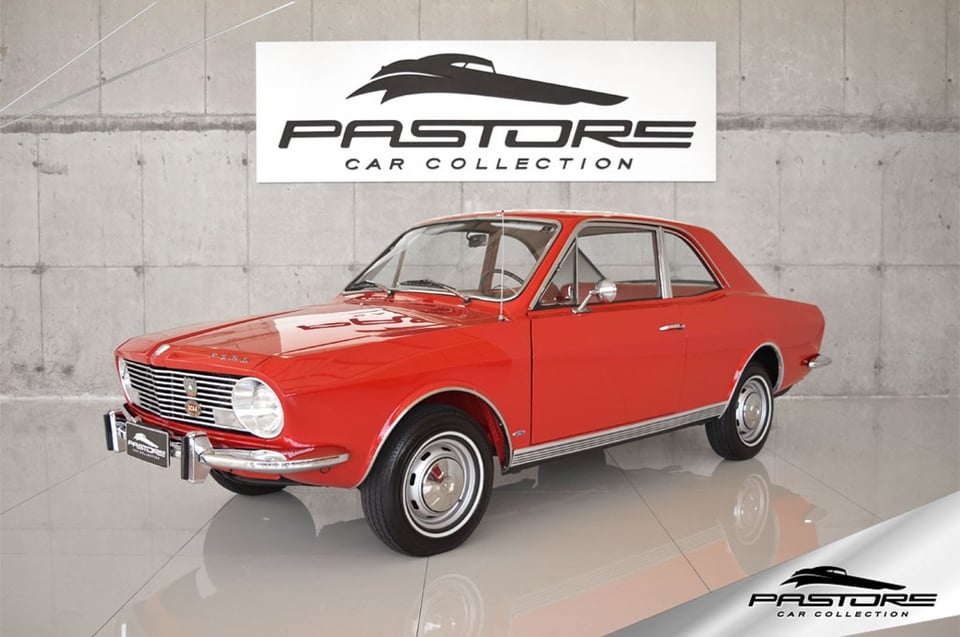
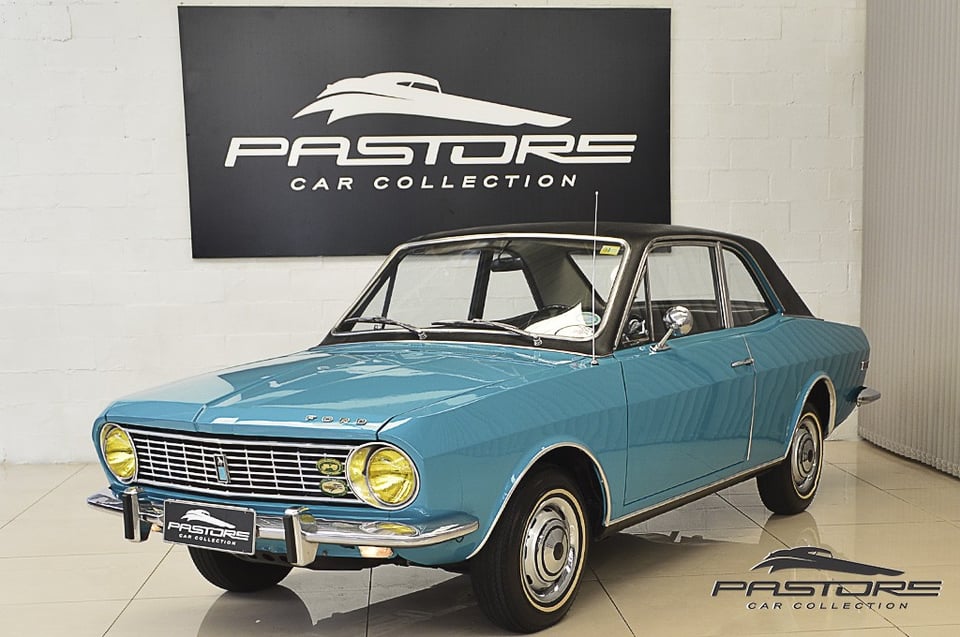
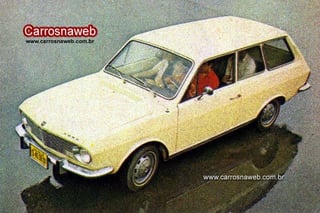
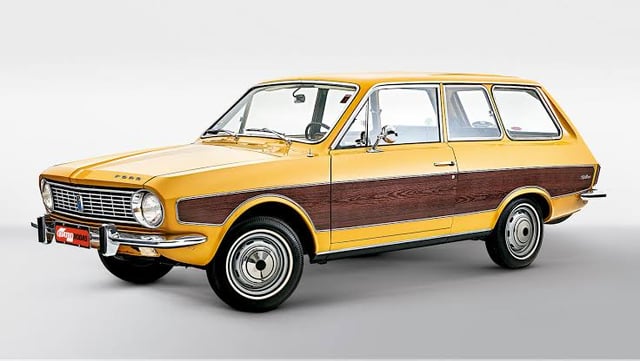
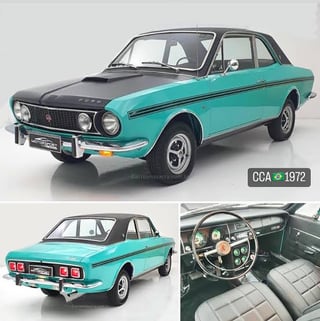
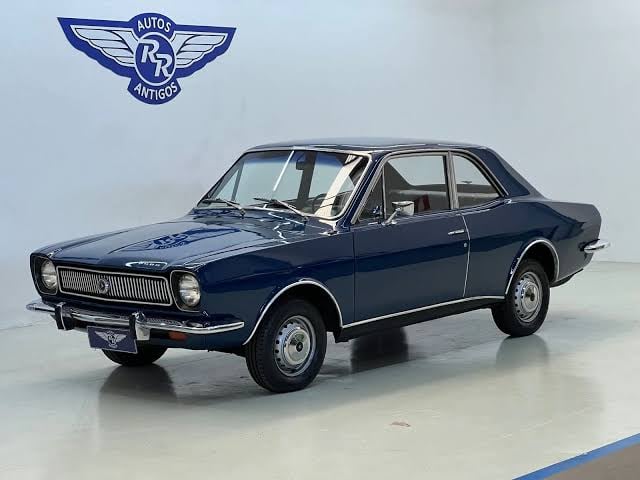
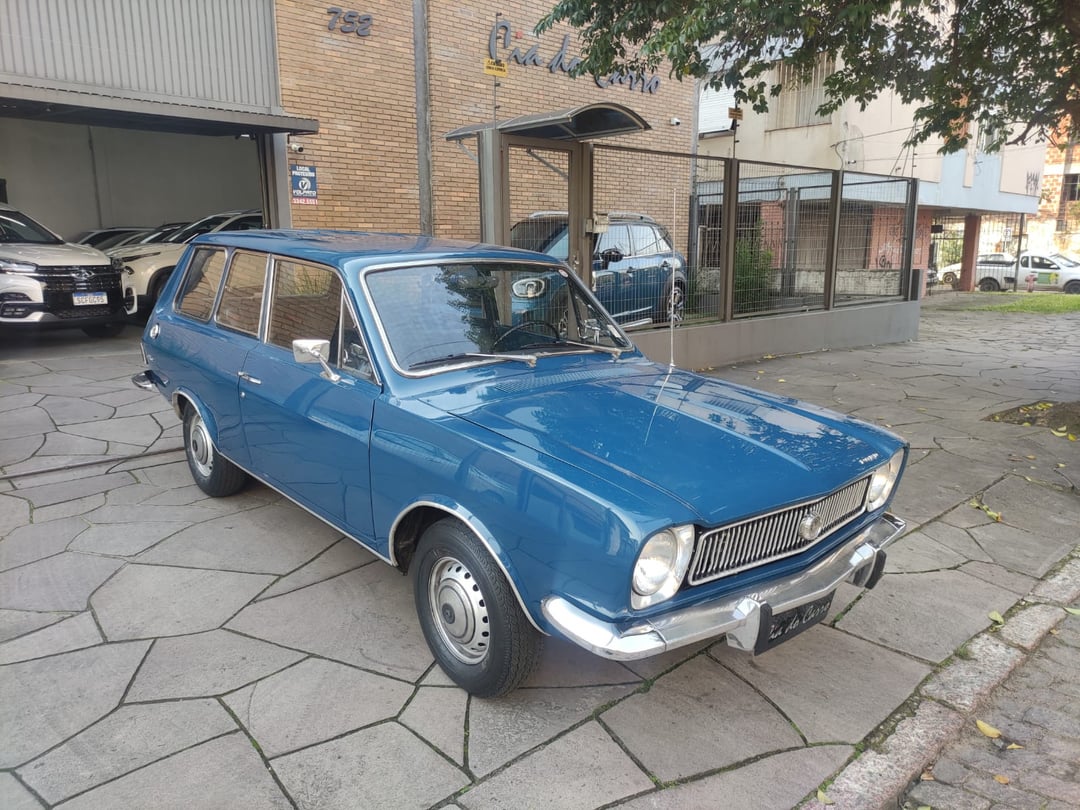
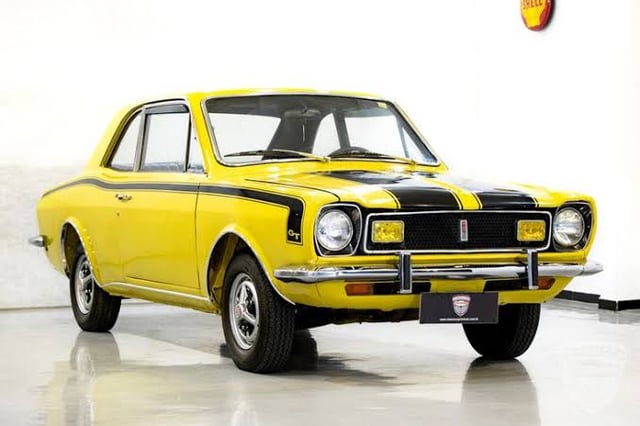
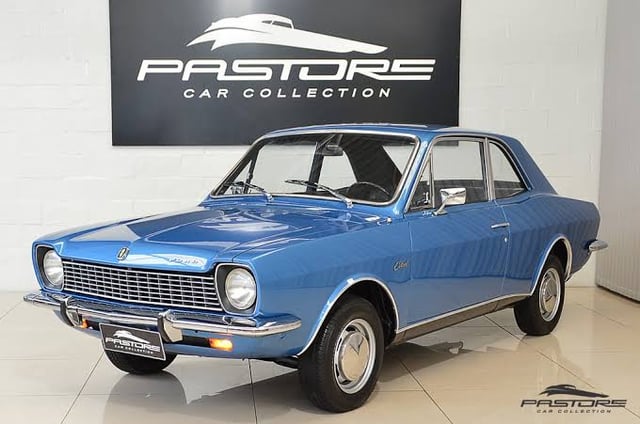
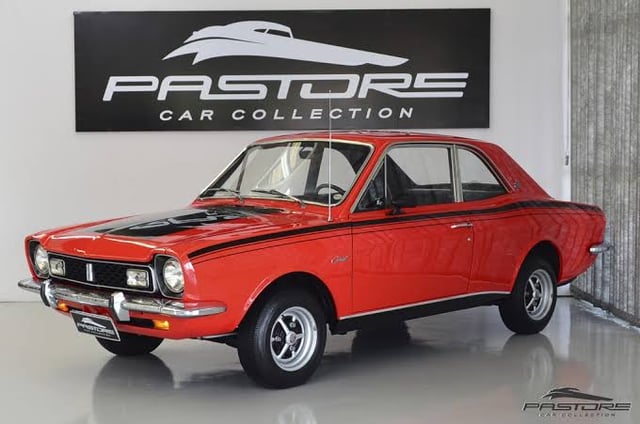
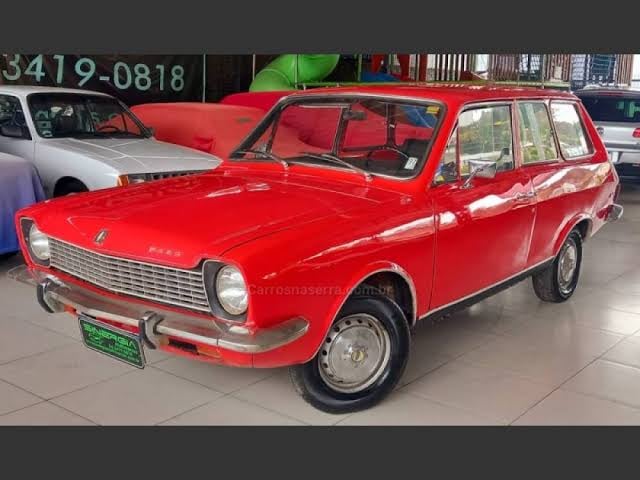
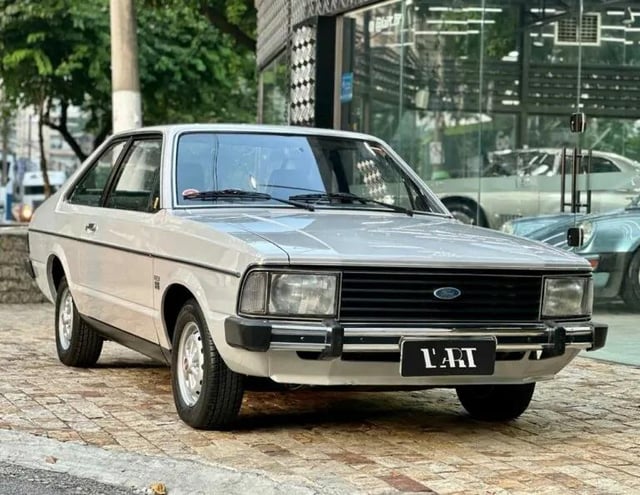
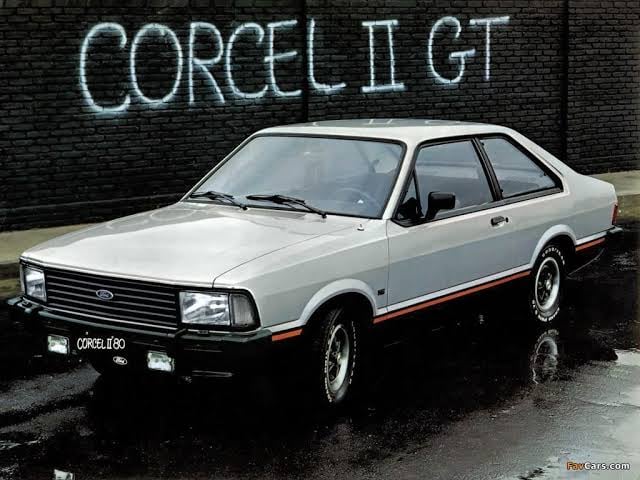
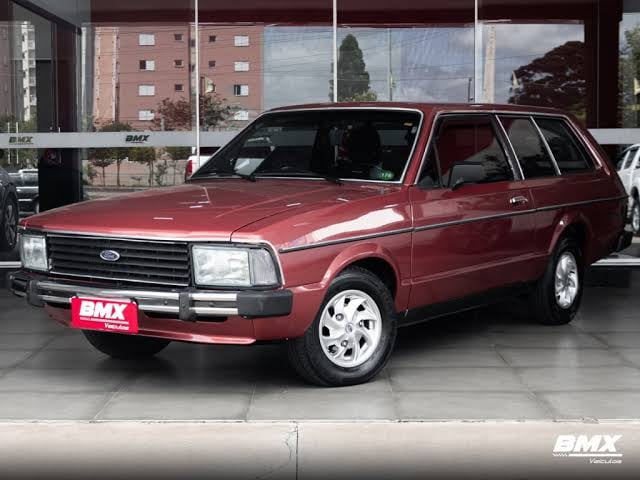
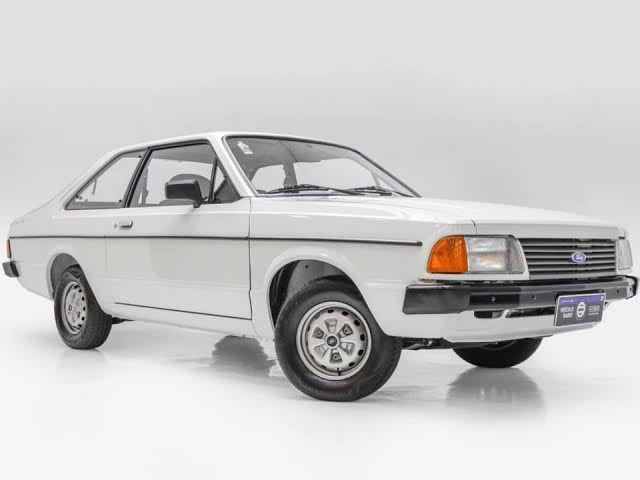
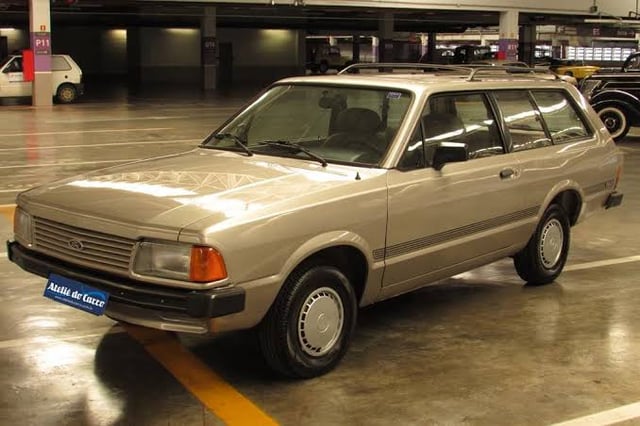
THE BEGINNING OF THE CORCEL – PROJECT M
The Corcel is a medium-sized automobile produced by Ford in Brazil, from 1968 to 1986. However, its history does not begin with Ford, but rather with Willys and Renault. The French brand Renault, in partnership with Willys Overland of Brazil, were developing a project for a new passenger car, which became known as “Project M” and which years later in France gave rise to the Renault 12, while here in Brazil it gave rise to the Corcel.
In Brazil, the development of this vehicle was marked by the purchase of Willys by Ford in 1967. As a result, all Willys of Brazil projects and vehicles were now controlled by Ford, including the “Project M”, which was renamed the Ford Corcel. Thanks to Ford, this vehicle underwent a series of improvements to adapt to the terrible Brazilian roads.
1968 AND 1969
Presented to the public at the 1968 Auto Show, the Ford Corcel was the first mid-size sedan from Ford Brazil, but it was initially only available in the four-door sedan body style. Its sales began the following year.
The Ford Corcel stood out for its beautiful appearance, which was composed of straight lines, with emphasis on its front end marked by creases on the hood and the chrome grille with horizontal strips, with emphasis on the raised central part to follow the design formed by the creases on the hood, while the circular headlights were accompanied by the turn signals, located in the lower part of the grille near the headlights, just below was the chrome bumper, with the license plate mounted in the center. On its side, the look is marked by the charm of the four-door sedan body, and by the crease that ran along its entire side, while the 13-inch wheels were accompanied by chrome hubcaps, a highly praised detail was its large glass area, which privileged visibility in any direction. At the rear, the main highlight is the rectangular-shaped taillights and the chrome bumper, another detail to note was the spacious trunk with capacity for up to 458 l or 16.17 ft³.
Initially, it was only available in the basic version, called Standard. This version had a simple but well-finished interior, with a focus on the great interior space, which could seat up to five people in relative comfort thanks to the full-length seats, its generous wheelbase and its straight-line design. The dashboard had a simple design, but with details such as a glove compartment, ashtray and radio, while the instrument panel had only the essentials for the time: fuel gauge, speedometer, engine temperature and warning lights, the steering wheel was huge with two spokes and the gearshift lever was located on the floor.
Under the hood, the Ford Corcel was equipped with the Sierra engine, from Renault’s Cléon-Fonte engine family. This 1.3-liter, four-cylinder engine developed 68 horsepower at 5200 rpm and 9.8 kgfm or 96.10 Nm of torque at 3200 rpm. This power and torque were governed by a four-speed manual gearbox.
This mechanical set, combined with the low weight of 945 kg or 2083.37 lbs, allowed the Corcel to go from 0 to 100 km/h or 0 to 62 mph in 23.6 s and reach a maximum speed of 129 km/h or 80.2 mph.
A highly praised detail about the Corcel was its consumption, with averages of 10 km/l or 23.52 mpg in the city and 13.4 km/l or 31.52 mpg on the highway, very good averages for the weight and size of this vehicle at the time.
Another detail that deserves praise is the safety aspect, such as the hood that opens from back to front, so even if it is unlocked, the force of the wind when the vehicle is moving prevents it from opening, blocking the driver’s view. In addition, it is also important to highlight the split steering column that collapsed if the driver hit the steering wheel, which prevents more serious fractures, and the brakes, which, despite being drum brakes on all four wheels, like almost all Brazilian cars of the time, had the option of being disc brakes on the front.
An interesting detail is that the Ford Corcel was the first Brazilian car to come with a sealed cooling system. This system works like this: instead of letting the coolant evaporate, it was directed to an expansion tank, so that, when necessary, the excess liquid in the expansion tank was sucked back into the radiator. This system eliminates the need for frequent water replenishment in the radiator.
With all these innovations, the result could not be different. The Corcel was a success from the beginning and based on this, Ford decided to expand its range of versions in 1969.
The first version created thanks to the sudden success of the Ford Corcel was the two-door coupe version. This version stands out for having a sportier look, thanks to the design of the rear side with more muscular lines (somewhat reminiscent of the Maverick coupe and the Mustang) and the rear part of the roof with a smooth slope down to the height of the trunk. Another detail that may have favored the sales of this version was the fact that, at the time, the vast majority of Brazilians preferred cars with only two doors.
The second version created at this time was the Luxury version. This version had a more sophisticated finish, with details such as moldings, various chrome parts, new interior upholstery, individual front seats with reclining backrests and a dashboard with a padded upper part and details imitating Brazilian rosewood.
The third version created this year was the GT version, aimed at a younger audience. This version was only available in the two-door coupe body style and featured details such as a black vinyl roof with a GT logo on the C-pillar, black stripes on the sides, black paint on the hood and rear, fog lights and rubber-finished claws on the bumpers. Inside, the new features include the new three-spoke sports steering wheel, two-speed forced ventilation and a more complete dashboard with more gauges in the central part. Under the hood, the engine was the same, but with improvements that increased its maximum power to 80 hp and its maximum torque to 10 kgfm or 98.06 Nm. This allowed the Corcel GT to accelerate from 0 to 100 km/h or 0 to 62 mph in 20 seconds and reach a top speed of 138 km/h or 85.75 mph.
1970 – THE ARRIVAL OF THE BELINA STATION WAGON
In March 1970, the Ford Belina station wagon arrived, as demand for these types of vehicles was increasing in Brazil at that time.
The Ford Belina had exactly the same front design based on straight lines as the Corcel, and thanks to this square design, the straighter rear of the station wagon did not clash with the front, which made it a very attractive station wagon. Speaking of the rear, the look was completed by the rectangular lights in a vertical position and the enormous trunk lid that opened up to the height of the bumper, which made it easier to handle luggage.
Speaking of luggage, the trunk itself was incredibly spacious, especially considering the size of the car. It could hold up to 855 liters or 30.20 ft³ with all the seats in place and, if necessary, it was possible to fold down the rear seats, increasing the cargo capacity to 1680 liters or 59.32 ft³.
The Ford Belina had the same qualities as the Ford Corcel and had the same versions as the sedan, these being the Standard and Luxury versions.
Still in 1970, the Ford Belina gained a touch of refinement and luxury with the Special Luxury version.
Also known as the Belina Woody, this curious version featured details such as whitewall tires and plastic appliques imitating Brazilian rosewood on its sides and trunk lid, which were outlined by chrome strips. Inside, the station wagon featured an even more sophisticated finish, similar to that of the Corcel GT, with a dashboard with several chrome details, radio, nameplate on the glove compartment lid, bouclé carpets, courtesy lights and a windshield with defroster, as well as a steering wheel inherited from the Aero-Willys (a luxury car that coexisted with the Ford Galaxie in Brazil) and the optional full-length front seat.
1971
The following year, the Corcel line received its first restyling, with a new front grille with horizontal and vertical stripes in a checkered pattern and a new emblem in the center. The turn signals were moved and were now located below the bumper. The only new features at the rear were the new taillights, which were square-shaped, with two on each side on the sedan and coupe and in the station wagon they were wider and invaded the trunk lid.
The GT version also received new features, such as new fog lights, now embedded in the new black grille and featuring the GT logo in the center. The hood was painted black and had a fake air intake in the center.
1972
In 1972, the Special Luxury version of the Ford Belina was discontinued due to low sales.
The GT version was renamed the Corcel GT-XP and received further improvements, such as new wheels with a sporty design and new side stripes. Inside, the gauges, which were previously located in the central part of the dashboard, were relocated to the central console.
The engine is still the same Renault engine, but has undergone further improvements and had its displacement increased to 1.4 liters, with all these improvements this engine now developed a power of 85 hp at 5400 rpm and 11.6 kgfm or 113.76 Nm of torque at 3600 rpm. This engine allowed the Corcel GT-XP to go from 0 to 100 km/h or 0 to 62 mph in 16.6 s and reach a top speed of 144 km/h or 89.48 mph.
1973
In 1973, the Corcel line underwent a new restyling, now more in-depth and concentrated mainly on the front end, which gained a new hood, with a more aerodynamic design, a new grille with vertical stripes and a new emblem in the center and new headlight frames, the license plate was removed from the bumper and was now positioned below it and the turn signals gained a new design. At the rear, the taillights gained a new design, now in a rectangular shape and equipped with reverse lights, though they were a bit smaller in the Ford Belina. Inside, the only new feature was the new dashboard which, regardless of the version, was only available in matte black.
Another new feature was the 1.4-liter Renault engine with 75 hp at 5400 rpm and 11.6 kgfm or 113.76 Nm of torque at 3600 rpm. This became a standard item in all versions and allowed the Corcel and Belina to go from 0 to 100 km/h or 0 to 62 mph in 18.2 s and reach a maximum speed of 133 km/h or 82.64 mph.
The GT version featured new details such as a grille with built-in rectangular fog lights, new stripes on the sides and double stripes on the hood.
1975
For the year 1975, the Corcel line gained more new features, such as a lower hood with the logo in the center, a new grille, now made of plastic and with horizontal stripes, new hubcaps, split rear lights and a gauge with square gauges and the Belina’s trunk lid’s glass has also been enlarged.
Another new feature for this year was the more luxurious version for the sedan and station wagon, called LDO. It stood out for having a more sophisticated finish with a vinyl roof, chrome trim on the wheel rims, painted stripes on the sides and the sporty wheels of the GT version, but without the black details. Inside, it gained new upholstery, with a dashboard and seats in brown and beige and a new two-spoke steering wheel, exclusive to this version.
The GT version only gets aesthetic updates such as new side and hood stripes and new exterior mirrors.
1977 AND 1978
From its launch until the beginning of 1977, the Corcel had undergone few changes to its appearance, but the end of that same year was marked by its new generation, called Corcel II.
Already presented as the 1978 line, the new Corcel and Belina stood out for their beautiful appearances that followed the trend of the time, consisting of straight lines and a two-door fastback and wagon body respectively. At the front, the main highlight was the new front end with rectangular headlights and the turn signals, now located at the ends, next to the headlights. The new grille came in black and had the Ford logo in the center. In addition, it is also worth noting the aerodynamic design of its horizontal blades that provided a more intense air flow even at low speeds. The bumper, depending on the version, could come painted black or chrome. Unlike the first generation, the Corcel II and Belina II were only available in the two-door body style due to the taste of Brazilians at the time. Based on this information, the best solution was to adopt two huge front doors to facilitate access to the rear seat. The main highlight at the rear of the Corcel II is the smooth slope of the C-pillar to the trunk lid, while the license plate comes out of the bumper and is now mounted between the taillights, which have a new design, more rectangular and smooth. The Ford Belina II had the same updated design on the front as the Corcel II, and just like in its first generation, the straight lines helped the rear of the station wagon to harmonize with the front, this rear had new square-shaped taillights that were very small. The trunk capacity has been reduced due to the design of the body on both the Corcel II and Belina II, now with a capacity of 388 liters or 13.70 ft³ on the sedan and 768 l or 27.12 ft³ with all the seats in place on the wagon.
Although it gave the impression of being larger and more spacious, its dimensions were basically the same for both the fastback and the wagon, with the exception of a width that was 4 cm or 1.575 in larger.
Inside, the Corcel II and Belina II were more luxurious and sophisticated, with better thermal and acoustic insulation, a better internal circuit in the dashboard, an efficient air renewal system in the cabin, the first laminated windshield in Brazil, a fully carpeted interior, and reclining front seats. The dashboard, now made entirely of plastic, had a very attractive design for the time. The gauge cluster displayed all the information in three circular gauges: the largest on the left was the speedometer, the smallest in the center was the clock, and the largest on the right was the fuel level indicator and warning lights, the steering wheel had two spokes on the Standart and L trim levels and four on the LDO top-of-line model of both the Corcel II and Belina II.
When talking about trim levels, the Corcel II was available in three trim options Standart, L and LDO while the Ford Belina was available only on the L and LDO trim options.
The basic, Standart, trim (only available for the Corcel II) had a simpler finish, without side moldings, with black-painted bumpers and wheels with a closed central core painted black.
The intermediate L version had moldings in the middle of the side, chrome bumpers and wheels with a red central core and a crown design in the center; the rear side windows of the Belina II where solid as a standard or could be divided with a tilting opening as an optional extra.
The luxurious LDO version was equipped with chrome bumpers with rubber details, side moldings in the lower part of the side, and new wheels, also with a red central core and a crown design in the center and the rear side window tilting as standard on the Belina II LDO. On the inside the LDO version had the charm of a monochromatic interior in shades of brown and imitation Brazilian rosewood on the dashboard.
The Corcel II and Belina II were equipped with the same 1.4-liter Renault engine as the first-generation Corcel and Belina, but with power reduced to 72 hp at 5,400 rpm and torque of 11.5 kgfm or 112.78 Nm at 3,600 rpm, and a four-speed manual transmission. This powertrain gave the Corcel II and Belina II an acceleration from 0 to 100 km/h or 0 to 62 mph of 17.2 s and a top speed of about 142 km/h or 88.235 mph. In terms of fuel consumption, the Corcel II averaged 8.5 km/l or 20 mpg in the city and 13.9 km/l or 32.7 mpg on the highway.
Another new feature for 1978 was the introduction of the new GT version. The new GT’s appearance was marked by black paint on the upper part of the body up to the C-pillar and outlined by red and yellow painted stripes, as well as exclusive details such as black wheels with chrome rims and fog lights below the bumper. Inside, the new features included a new three-spoke sports steering wheel, new instrumentation on the center console and a tachometer in place of the analog clock. Unfortunately, there were no changes to the engine, which maintained the same 72 hp.
1979
In 1979, more new features appeared for the Corcel line, such as new transparent headlights and turns signals on the front and ribbed tail lights on the Corcel II and new optional extras such as a five-speed manual transmission, headlight washer, rear window washer and wiper (only for the Belina II) and the new 1.6-liter Renault engine. This new engine belongs to the same family as the 1.3 and 1.4 engines previously used in the Corcel line and generated a maximum power of 90 hp at 5600 rpm and a maximum torque of 13 kgfm or 127.49 Nm at 4000 rpm.
The GT version also undergoes improvements, such as new black stripes, located on the lower part of the body, stiffer suspension and black bumpers. Meanwhile, the 1.6 engine and the five-speed manual transmission become standard items in this version. This allowed the Corcel II GT to go from 0 to 100 km/h or 0 to 62 mph in 15.9 seconds and reach a top speed of 151 km/h or 94.45 mph.
1980
In 1980, more new features appeared for the Corcel line, such as bumpers with plastic tips, a coolant temperature gauge and optional extras such as radial tires, three-point seat belts and a sunroof with tinted glass. The GT version gained a red trim along with black paint.
This same year was marked by two new features in the Corcel line. The first was the launch of a new version called the Corcel II Hobby, aimed at a younger audience. The Hobby version stood out for its more laid-back look, marked by the bodywork without many chrome details and black wheels with a chrome rim. Inside, the new features of this version include the new interior upholstery and the seats in red and black, the sports steering wheel inherited from the Corcel GT and the dashboard with a silver finish. The second new feature was the introduction of an ethanol-powered engine, which lost power but gained torque at low revs and was more economical. When modified to use this fuel, the 1.6 engine developed 69 hp at 4800 rpm and torque of 12.4 kgfm or 121.6 Nm at 2800 rpm. This resulted in acceleration from 0 to 100 km/h or 0 to 62 mph in 19.5 seconds and a top speed of 146 km/h or 90.72 mph. Regarding fuel consumption, the Corcel II averaged 6.3 km/l or 14.82 mpg of ethanol in the city and 11 km/l or 25.87 mpg of ethanol on the highway (keep in mind that ethanol was and still is much cheaper than petrol in Brazil so despite the actual numbers not being better than the petrol version, in the end it was less costly to have ethanol on the tank).
FORD CORCEL HOBBY PHOTOS: https://motortudo.com/ford-corcel-ii-hobby-1978-customizado-com-motor-ap-2-0i-a-alcool/
1981
In 1981 very few things happend, with the only noteworthy thing being that the Corcel II’s taillights gained black trim.
1982
The year 1982 was marked by improvements to the Corcel and Belina’s gearbox and suspension, as well as new items such as hollow headrests, a new central console with a digital clock and air conditioning, available only as an optional extra.
There were plenty of new versions derived from the Corcel and Belina launched this year.
Firstly the limited edition “Five-star” Corcel and Belina models hit the market. The Five-star Series was based on the L version and it was offered in the exclusive metallic gold color with sporty iron wheels, digital clock and tachometer.
Then the curious Corcel II Van version appeared, which was basically a cargo van version of the Belina II, but with metal sheets instead of rear windows, a flat floor and a dividing grid that separated the front seat occupants from the cargo compartment. Speaking of cargo, this vehicle could transport a weight of up to 440 kg or 970 lbs and a volume of 1620 liters or 57.21 ft³.
Then the Ford Pampa, the pickup truck derived from the Corcel arrived, bringing the robustness of a true pickup truck, combined with the comfort of a passenger car.
Then the brand’s new and luxurious sedan, the Ford Del Rey, was launched, which, despite its objective being to replace the already outdated Ford Landau (a car that was created to be the most luxurious version of the Brazilian Ford Galaxie and later became its own car), ended up, in a way, stealing consumers from the Corcel.
FORD CORCEL FIVE-STAR PHOTOS: https://armazemdovovo.com.br/anuncio/avv-ford-corcel-ii-l,-serie-5-estrelas-venda-7df33f6
FORD CORCEL II VAN PHOTOS: https://encrypted-tbn0.gstatic.com/images?q=tbn:ANd9GcRMDppqIZWttDRK4kWXuBjzU4PRFwWMGd517veoZAIXaAGjdRyOdP2gIws&s=10
1983
A new limited series came in 1983, this one called Corcel II the Champions. Available only in black with gold side stripes and gold wheels, fog lights, four-spoke steering wheel, tachometer and digital clock on the center console.
This year, the Brazilian version of the Ford Escort also appeared. A global concept car with a modern and sporty look, just like the Del Rey, it soon began to steal consumers from the Corcel.
FORD CORCEL THE CHAMPIONS PHOTOS: https://thegarage.com.br/carro/1983-ford-corcel-ii-campeoes/
1984
In 1984, the versions’ names were changed; the basic version, which was previously called Standard, was now called L, the intermediate L was now called GL and the LDO and Hobby versions stopped being produced due to the fact that the positions of luxury midsize car for older people and simpler midsize car for younger people were already occupied by the Ford Del Rey and Ford Escort respectively.
Still in 1984, the second edition of the special Five-star series was released. This version was even more special, with exclusive metallic green paint, sophisticated black interior, black moldings highlighting the beauty of the lines, red and black side stripes for a more personalized touch, special door interior finish, sportier front seats with a new design and, in the five-star Belina, two more very special items: a practical black luggage rack on the roof and a very useful luggage compartment protector.
Another new feature for this year was the introduction of the new CHT engine, the same as the Ford Escort with 1.3 or 1.6 liter options, powered by petrol or ethanol.
1985
Nearing its end, the Ford Corcel II received its first and only restyling with new trapezoidal headlights, a new grille and new taillights. Inside, it received a steering wheel and dashboard similar to those of the Del Rey but with less refinement. The digital clock was removed from the central console and was now located on the ceiling, next to the rearview mirror.
Also in 1985, the last special series of the Corcel arrived, the Astro series. The special series was made to end production of the Corcel line and came in two colors: silver and quartz gold. The edition received black adhesive side strips, a digital clock with calendar and reading lights on the ceiling, a grille in the same color as the vehicle, super hubcaps and window frames, black door handles and beige interior trim.
FORD CORCEL AND BELINA ASTRO SERIES PHOTO: https://encrypted-tbn0.gstatic.com/images?q=tbn:ANd9GcS90ImfVCpwpTJRSqrMeLWJujeK05ytL4ZbsJtQikSYAS2WFuznBbj9-lU&s=10
1986
With the arrival of newer and more modern vehicles year after year, the Corcel’s appearance was already beginning to affect its sales and, based on this result, in 1986 the Corcel line came to an end with more than 4 million units sold in its 18 years of production.
TRIVIA
·1: What is interesting is that although the Renault and Ford models had completely different designs, they shared the same platform, engines and wheels that had three holes and which became famous in Brazil for exactly this reason.
·2: The name Corcel, means Steed in Portuguese and was chosen as a homage to the Ford tradition of naming cars after horse breeds, mainly the Mustang.
SOURCE: https://youtube.com/@reliquiaautomotiva?si=-6At4kPLSU6LKPB9
by OriginalPapaya8




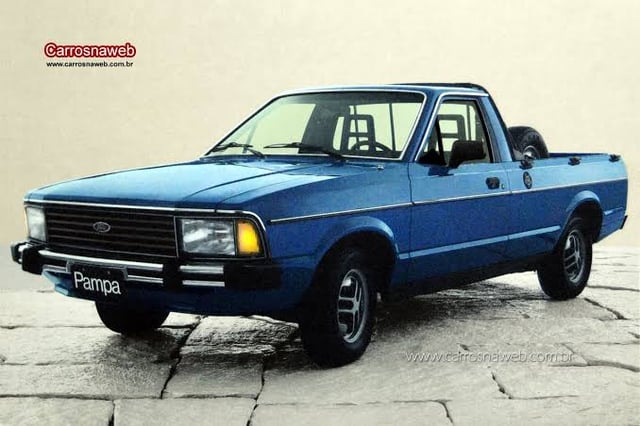


4 Comments
PARTS OF THIS “SERIES”
PART 2 – FORD DEL REY: https://www.reddit.com/r/WeirdWheels/s/VivpKpLPws
PART 3 – FORD PAMPA: https://www.reddit.com/r/WeirdWheels/s/gRE3ekf7NZ
You can still sort of see the Renault 12 structure in the first version of the Corcel sedan and Belina. That was completely gone with the Corcel II.
That wagon is pimp! I’d love to get my hands on my dream car of a 56 Chevy Wagon, but I’d settle for this little beaut!
Brazil got such cool and unique cars.